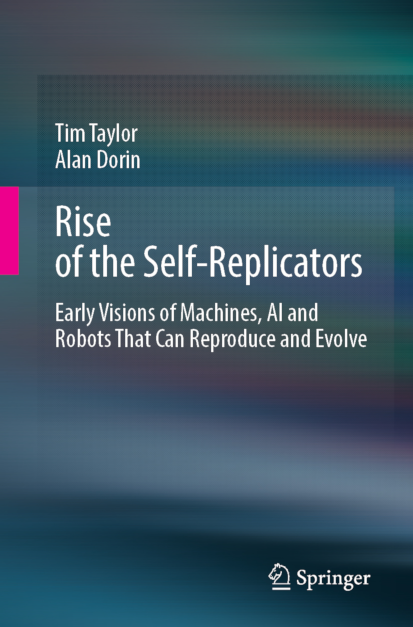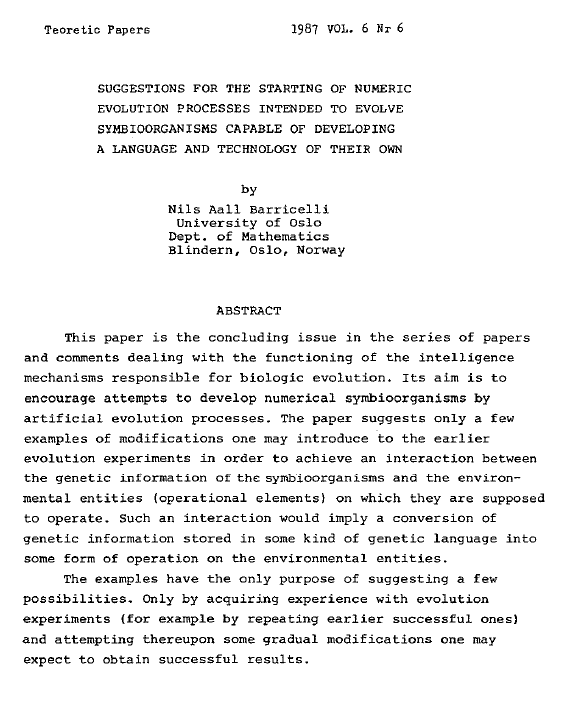Book details
Rise of the Self-Replicators
Early Visions of Machines, AI and Robots That Can Reproduce and Evolve
Tim Taylor and Alan Dorin

In Rise of the Self-Replicators we delve into the deep history of thought about machines, AI and robots that can reproduce and evolve. Although these might seem like very modern concepts, we show that people were thinking about them as far back as the mid-1600s and that the discussion gathered pace in the 1800s following the British Industrial Revolution and the publication of Darwin's On The Origin of Species.
Behind all of the work we discuss lie two central questions:
- Is it possible to design robots and other machines that can reproduce and evolve just like biological organisms do?
- And, if so, what are the implications: for the machines, for ourselves, for our environment, and for the future of life on Earth and elsewhere?
The core of the book provides a chronological survey and comprehensive archive of the early history of thought about machine self-reproduction and evolution. It covers work by scientists, philosophers, science fiction writers and engineers, including many examples that have not been discussed elsewhere before now.
We show that the work described can be categorised into two main flavours: one concerned with the evolutionary potential of such technology as a route to superintelligent AI, and the other concerned with the general manufacturing capabilities of self-reproducing machines with potential long-term applications including the colonisation of other worlds.
We conclude with a discussion of what we consider to be the most likely directions for future work, emphasising that the management of risk in the development of this technology should be based upon a firm understanding of the issues at stake. In doing this, we hope to inspire a broad community discussion about the significant implications of intelligent evolving machines.
Rise of the Self-Replicators will be of interest to the general reader and a valuable resource for researchers, practitioners, and historians engaged with ideas in artificial intelligence, artificial life, robotics, and evolutionary computing.
- 9 Dec 2024 I am pleased to announce that the Read Online version of the book has now been updated to the second edition of the author-formatted version, including the 2024 afterword as the new Chapter 8.
- 10 Oct 2024 A new second edition of the author-formatted version of the book is now available, including the 2024 afterword (which was published as a paper in the Artificial Life journal earlier this year) as an additional chapter. I am hoping to get the Read Online version similarly updated in the near future. Note, there are no plans for a second edition of the official Springer version of the book at this stage.
- 31 Jan 2024 A new afterword to Rise of the Self-Replicators is now out! It describes several relevant sources that have come to my attention since the book was published. The afterword is published in the thirtieth anniversary edition of the Artificial Life journal (vol. 30, no. 1, 2024), and a free author-formatted preprint of the paper is available here!
- 24 May 2022 A copy of Nils Aall Barricelli's final paper on the evolution of self-replicating digital organisms has been posted in the Additional Materials section of this page!
- 26 Nov 2021 A brand new free web version of the book is now available to read online!
- 29 Oct 2021 The book received another good review in the journal Technology and Culture.
- 23 Sep 2021 The book received another nice review, this time in the journal Artificial Life.
- 19 Jul 2021 Tim gave a keynote talk about the book at the 2021 Conference on Artificial Life.
- 15 Feb 2021 The book received a nice review in the journal Genetic Programming and Evolvable Machines.
- 16 Oct 2020 The free author-formatted PDF version of the book is now available to download here!
- 16 Oct 2020 The book has received some nice endorsements!
Sci-fi movies and novels about self-replicating machines are but the tip of a very deep intellectual iceberg whose roots reach centuries back in time and tap rich veins of thought in literature, philosophy, and mathematics. Taylor and Dorin, active researchers in their own right at the bleeding age of such technologies, provide a masterful tour through this fascinating and little-known historical landscape. This book will fascinate a wide range of readers, from those who just love Terminator movies, to those who wish to think more deeply about where technology came from and where it may be taking us.
... the topics reviewed in the book Rise of the Self-Replicators ... may become a major scientific focus beyond the current AI-hype. The book ... provides an intriguing historical perspective on the origin of the ideas around self-replication and evolution in machines. ... Rise of the Self-Replicators is a great read, and highly recommended ...
Rise of the Self-Replicators is undoubtedly exciting and inspirational for its primary audience—fellow members of the ALife community—as well as for philosophers, science fiction enthusiasts, and futurists. ... Historians of technology will benefit from [the book] if they use it as a compendium of intriguing primary sources, which they can contextualize, interpret, and analyze in accordance to their own research agendas and motivations.
Taylor and Dorin have done an excellent job; they have performed a deep search in many libraries and archives, have contacted historians and experts from various fields and various countries, and have checked the original sources written in non-English languages. ... [They] have performed a fascinating survey on self-replicators, and also have enriched the book with engaging stories and details about how the key people in this field are interconnected. ... [An] excellent book.
Buy the official Springer version of the book in softcover or ebook format from the Springer store (also available to subscribers of SpringerLink), Amazon and other online and physical book stores.
If Springer has ever published any of your work, such as a paper in a conference proceedings, you are eligible for a 40% discount on any of their publications. You'll need to register for a MySpringer account if you have not already done so. Note that you won't see the 40% discount price while browsing their catalogue, but it will be applied when you add an item to your shopping basket.
As provided for in our publishing agreement with Springer, we are pleased to also offer free author-formatted versions of the entire book, to read online and to download in PDF format.
- Provides the first comprehensive early history of machine self-reproduction and evolution.
- Covers the period of roughly 1650-1960 and includes a summary of more recent work that has been covered elsewhere.
- Synthesizes contributions from philosophy, science fiction, science and engineering.
- Uncovers many examples that have never been discussed in the AI and Artificial Life literature before now.
- Considers the relevance of this early work to current debates about the future of AI.
- Primarily aimed at an academic audience, but also accessible to a wider readership.
Nils Aall Barricelli's final paper on the evolution of self-reproducing digital organisms
At the end of Section 5.2.1 of the book there is a discussion of Barricelli's final paper about his digital "symbioorganisms", published in 1987. In it Barricelli discusses how his system might be improved to allow for the evolution of more complex organisms. The paper appeared in a technical report series of the University of Oslo entitled Theoretic Papers and is quite hard to get hold of, so I am posting a copy of it here.
The paper can be cited as follows:
Barricelli, N. A. (1987). Suggestions for the starting of numeric evolution processes to evolve symbioorganisms capable of developing a language and technology of their own. Theoretic Papers, 6(6), 119–146. University of Oslo.
Films of Lionel Penrose's explorations of physical self-replication
As described in Section 5.3.1 of the book, the British scientist Lionel Penrose commissioned two films to demonstrate his studies of mechanical models of self-replication. From the mid-1950s to the early-1960s he designed and built a series of ingenious and increasingly complex wooden contraptions capable of catalysing the formation of more of their own kind when provided with a supply of basic units to fuel the reproduction process.
Automatic Mechanical Self Replication (Part 1), 1958
Automatic Mechanical Self Replication (Part 2), 1961
